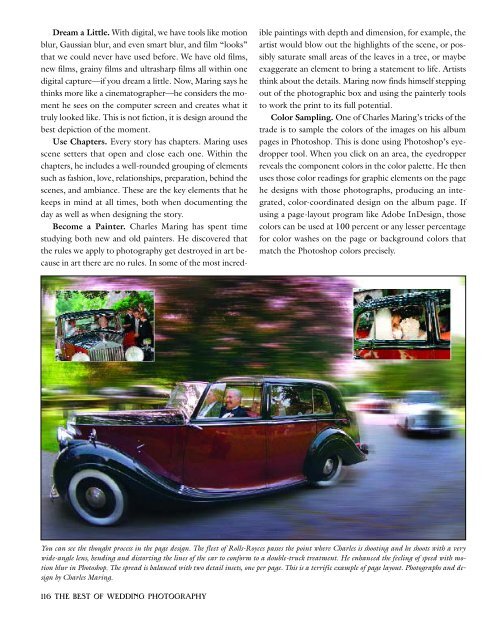The Best of Wedding Photography.pdf - Free
The Best of Wedding Photography.pdf - Free
The Best of Wedding Photography.pdf - Free
You also want an ePaper? Increase the reach of your titles
YUMPU automatically turns print PDFs into web optimized ePapers that Google loves.
Dream a Little. With digital, we have tools like motion<br />
blur, Gaussian blur, and even smart blur, and film “looks”<br />
that we could never have used before. We have old films,<br />
new films, grainy films and ultrasharp films all within one<br />
digital capture—if you dream a little. Now, Maring says he<br />
thinks more like a cinematographer—he considers the moment<br />
he sees on the computer screen and creates what it<br />
truly looked like. This is not fiction, it is design around the<br />
best depiction <strong>of</strong> the moment.<br />
Use Chapters. Every story has chapters. Maring uses<br />
scene setters that open and close each one. Within the<br />
chapters, he includes a well-rounded grouping <strong>of</strong> elements<br />
such as fashion, love, relationships, preparation, behind the<br />
scenes, and ambiance. <strong>The</strong>se are the key elements that he<br />
keeps in mind at all times, both when documenting the<br />
day as well as when designing the story.<br />
Become a Painter. Charles Maring has spent time<br />
studying both new and old painters. He discovered that<br />
the rules we apply to photography get destroyed in art because<br />
in art there are no rules. In some <strong>of</strong> the most incred-<br />
116 THE BEST OF WEDDING PHOTOGRAPHY<br />
ible paintings with depth and dimension, for example, the<br />
artist would blow out the highlights <strong>of</strong> the scene, or possibly<br />
saturate small areas <strong>of</strong> the leaves in a tree, or maybe<br />
exaggerate an element to bring a statement to life. Artists<br />
think about the details. Maring now finds himself stepping<br />
out <strong>of</strong> the photographic box and using the painterly tools<br />
to work the print to its full potential.<br />
Color Sampling. One <strong>of</strong> Charles Maring’s tricks <strong>of</strong> the<br />
trade is to sample the colors <strong>of</strong> the images on his album<br />
pages in Photoshop. This is done using Photoshop’s eyedropper<br />
tool. When you click on an area, the eyedropper<br />
reveals the component colors in the color palette. He then<br />
uses those color readings for graphic elements on the page<br />
he designs with those photographs, producing an integrated,<br />
color-coordinated design on the album page. If<br />
using a page-layout program like Adobe InDesign, those<br />
colors can be used at 100 percent or any lesser percentage<br />
for color washes on the page or background colors that<br />
match the Photoshop colors precisely.<br />
You can see the thought process in the page design. <strong>The</strong> fleet <strong>of</strong> Rolls-Royces passes the point where Charles is shooting and he shoots with a very<br />
wide-angle lens, bending and distorting the lines <strong>of</strong> the car to conform to a double-truck treatment. He enhanced the feeling <strong>of</strong> speed with motion<br />
blur in Photoshop. <strong>The</strong> spread is balanced with two detail insets, one per page. This is a terrific example <strong>of</strong> page layout. Photographs and design<br />
by Charles Maring.

















